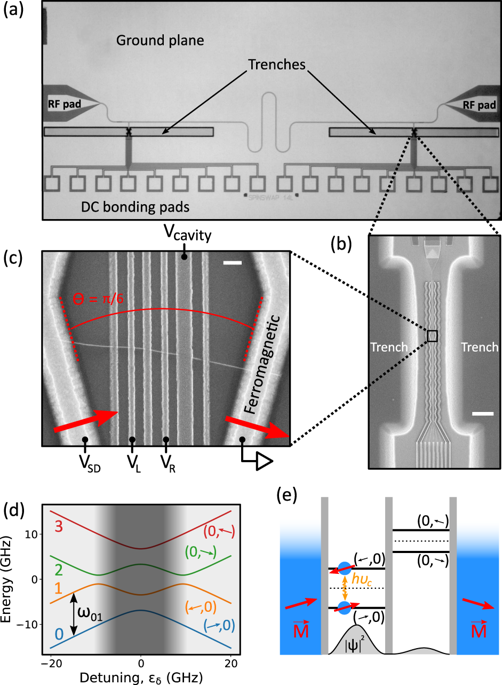npj Quantum Information ( IF 7.6 ) Pub Date : 2019-07-08 , DOI: 10.1038/s41534-019-0169-4 T. Cubaynes , M. R. Delbecq , M. C. Dartiailh , R. Assouly , M. M. Desjardins , L. C. Contamin , L. E. Bruhat , Z. Leghtas , F. Mallet , A. Cottet , T. Kontos

|
Spins confined in quantum dots are considered as a promising platform for quantum information processing. While many advanced quantum operations have been demonstrated, experimental as well as theoretical efforts are now focusing on the development of scalable spin quantum bit architectures. One particularly promising method relies on the coupling of spin quantum bits to microwave cavity photons. This would enable the coupling of distant spins via the exchange of virtual photons for two qubit gate applications, which still remains to be demonstrated with spin qubits. Here, we use a circuit QED spin–photon interface to drive a single electronic spin in a carbon nanotube-based double quantum dot using cavity photons. The microwave spectroscopy allows us to identify an electrically controlled spin transition with a decoherence rate which can be tuned to be as low as 250 kHz. We show that this value is consistent with the expected hyperfine coupling in carbon nanotubes. These coherence properties, which can be attributed to the use of pristine carbon nanotubes stapled inside the cavity, should enable coherent spin–spin interaction via cavity photons and compare favorably to the ones recently demonstrated in Si-based circuit QED experiments. Our clean and controlled nano-assembly technique of carbon nanotubes in the cavity could be further improved by purified 12C growth to get rid of the nuclear spins resulting in an even higher spin coherence.
中文翻译:

碳纳米管与腔光子耦合的高度相干自旋态
限制在量子点中的自旋被认为是用于量子信息处理的有前途的平台。尽管已经证明了许多先进的量子操作,但是实验和理论上的努力现在都集中在可伸缩自旋量子比特体系结构的开发上。一种特别有前途的方法依赖于自旋量子位与微波腔光子的耦合。这将能够通过虚拟光子交换两个量子位门应用实现远距离自旋的耦合,这仍然需要用自旋量子位来证明。在这里,我们使用电路QED自旋-光子接口来驱动使用腔体光子的基于碳纳米管的双量子点中的单个电子自旋。微波光谱法使我们能够识别出具有退相干率的电控自旋跃迁,该退相干率可调节至低至250 kHz。我们表明该值与碳纳米管中预期的超精细耦合相一致。这些相干特性可以归因于使用钉在腔体中的原始碳纳米管,它们应能够通过腔体光子实现自旋-自旋相互作用,并且与最近在基于Si的电路QED实验中证明的相干特性具有可比性。我们的清洁和可控的纳米碳纳米管在腔体中的组装技术可以通过纯化得到进一步改善 这可以归因于在腔内钉扎的原始碳纳米管的使用,应该能够通过腔光子实现自旋-自旋相互作用,并且与最近在基于硅的电路QED实验中证明的相比较。我们的清洁和可控的纳米碳纳米管在腔体中的组装技术可以通过纯化得到进一步改善 这可以归因于使用钉在腔体中的原始碳纳米管,它应能够通过腔体光子实现自旋-自旋相互作用,并且与最近在基于硅的电路QED实验中所证明的相比较。我们的清洁和可控的纳米碳纳米管在腔体中的组装技术可以通过纯化得到进一步改善12 C生长以摆脱核自旋,从而导致更高的自旋相干性。


























 京公网安备 11010802027423号
京公网安备 11010802027423号